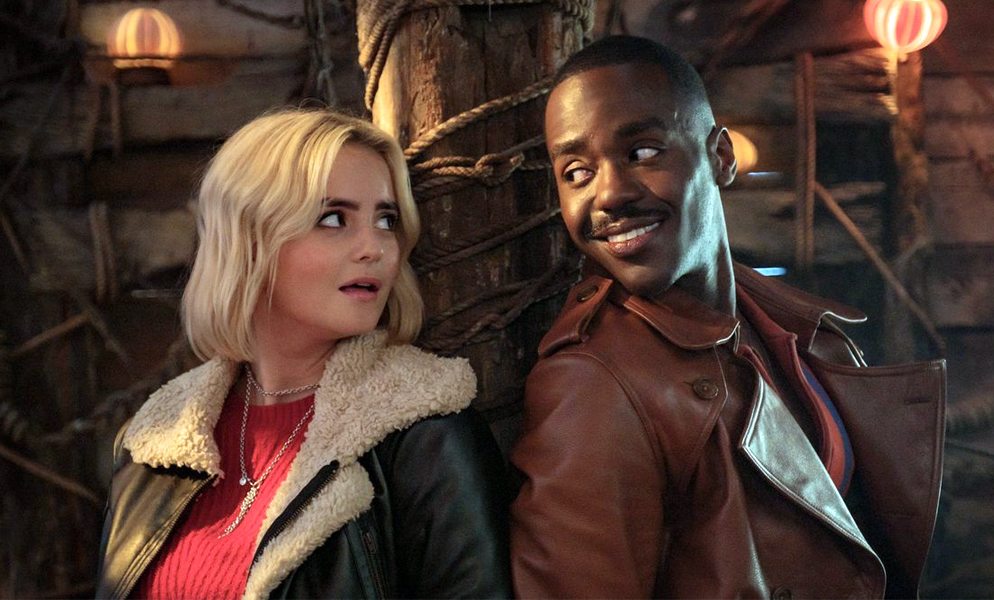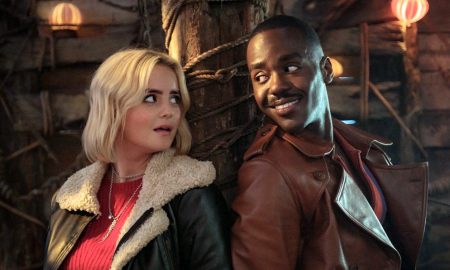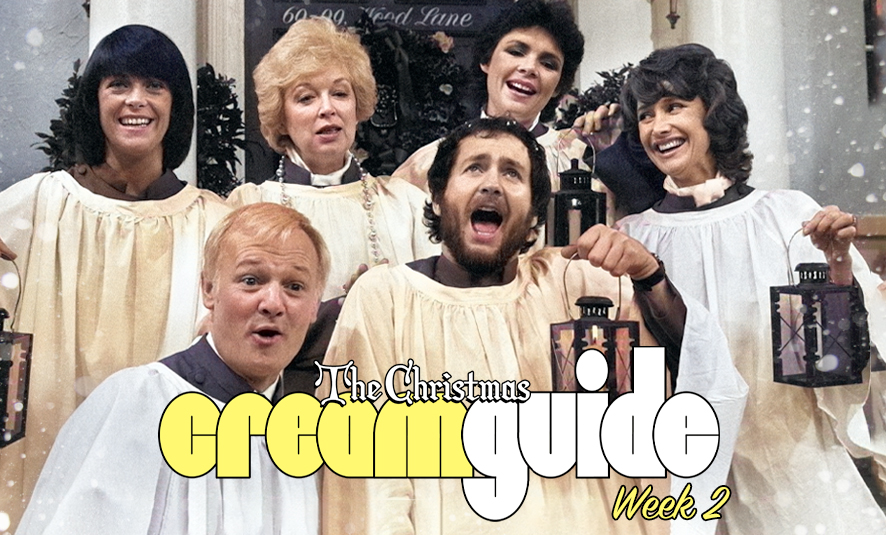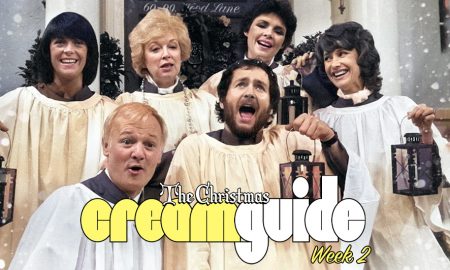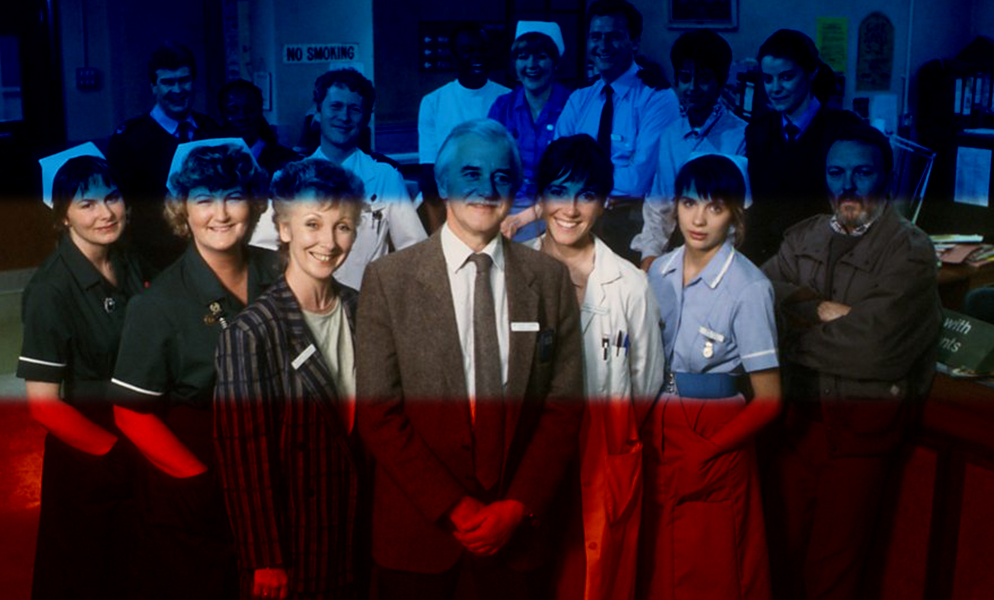
Also:
- It's Saturday Night
- 2. An autograph before you go
- 3. A new kind of game show
- 4. A rising exasperation with the quantity of dirt
- 5. The whole thing suddenly fell apart
- 6. Synthetic propensity
- 7. It was destined to be an anti-climax
- 8. This is your show now
- 9. The awesome scale of our wastefulness
- 10. Hands up those who couldn't care less
- 11. Together We’ll Be Ok
- 12. Decide the shape of ITV in the 1980s
- 13. Alan is too commercial
- 14. It worked like a dream
- 15. Older men, doing school boy tricks
- 16. Killing the Golden Goose
- 17. People love us to be sexy
- 18. The manure is worth more than the cattle
- 19. They were big in the States and we noted that
- 20. I’m still aggressive and I’m still handing out the insults
- 21. A new style of lunatic humour
- 22. The Habitat-bean-bag-hessian-wallpaper brigade
- 23. Thoroughly sinful
- 24. All carrots should be scraped, sliced and cooked
- 25. Back then it was radical stuff
- 26. Whatever they do, we can do it better
- 27. You'll have to take us as you find us
- 28. Entertainment that keeps on the move
- 29. It's the public that has to pay
- 30. The last we saw of either of them was their sad faces
- 31. Just shoot the bastard
- 32. Britain could clearly be facing its darkest hour
- 33. Any enthusiasm we may have had for continuing discussions is waning
- 34. It was considered by LWT and then put in a bottom drawer
- 35. Watch the redoubtable Terry take off
- 36. I thought it might be terrible and I wouldn’t enjoy it at all
- 37. Kamikaze Mastermind
- 38. We haven’t moved into luxury
- 39. We are investing in people
- 40. Delivered impeccably
- 41. He has to allow you to do your bit
- 42. All the anticipation of the great emotive point
- 43. If you want Russ Abbot to do it, then you have to accept me and my ideas
- 44. Let’s get straight into this
- 45. Unedifying Greed
- 46. We’ve got the fucking lot!
- 47. Scope for humour and danger
- 48. Pure Megablast
- 49. There’s lots of killing, but not much else
- 50. I wanted to make sure it was going to be disastrous
- 51. Oh dear – Auntie’s playing bingo!
- 52. A Shrivelled Little Thing
- 53. I shouldn’t have accepted it
- 54. We would be the spoilsports
- 55. The Most Sexless Person In Television
- 56. They’d have strung me up if I hadn’t chosen him
- 57. Is there some way to play with the internal constituent parts?
- 58. The most important entertainment programme of my time
- 59. The plumply pretty female duo
- 60. The audience just sort of started to freeze on him
- 61. More pilots than British Airways
- 62. There's going to come a time when you'll have to go to the BBC
- 63. A slightly pretentious manifesto
- 64. Things Look Very Precarious
- 65. It’s no good doing all the same old people all the time
- 66. That’s just not funny Bobby, it's corny - just don’t do that
- 67. Well bottom’s not funny
- 68. We Are The Funnymen
- 69. The powers that be listened to Denis
- 70. Stretchers never go up stairs
- 71. I was in obscurity until this series
- 72. I don’t care if he doesn’t like me
- 73. There’s such a passion for nostalgia right now
- 74. I Heard A Seat In The Stalls Go ‘Gerdonk!'
- 75. This is your show, folks, and I do mean you
- 76. There’s good news for perplexed fans of 3-2-1!
- 77. Taking on Blind Date would be a real challenge
- 78. You wanna bet on it?
- 79. The yarns worked their tried and tested magic
- 80. The Charge-And-Shout Brigade
- 81. I sat for a moment in silence, then turned in my chair and left the stage
- 82. We just weren't allowed into UK terrestrial television
- 83. Beadle’s A Prick
- 84. The interviewer always has to know when it's best to keep his or her mouth shut
- 85. Can you come up with a good solution for the Murder Weekend mystery?
- 86. He's not a goody- goody hero
- 87. The Sexism, The Dolly Birds, The Catchphrases
- 88. The feel of Saturday night
- 89. 1990 Who would employ an ex-alky with lowered self-esteem
- 90. It were a right smack in the face
- 91. Look Straight Into My Eyes And Everything Will Be Alright, That's A Promise
- 92. That's the last thing I was expecting, Jim
- 93. The characters and situations are real
- 94. Oh Man, There Go All My Women Fans
- 95. A Double Order of Talent
- 96. If there is an air of spontaneity about it, it’ll be genuine
- 97. NTV brings you ... empty rooms!
- 98. You’re BBC, you shouldn’t be here
- 99. If this doesn’t work out, we’re both snookered!
- 100. The humour of Beadle comes through humiliating people!
- 101. To allow such bilge on TV is an insult to the audience
- 102. Like a cup of cold sick
- 103. A litre of gin, ecstasy and crack cocaine
- 104. A reliable tent pole for Saturday evenings
- 105. It is in the cutlery drawer
- 106. Welcome to the new Saturday night
- 107. Congratulations, you have got the fucking Gen Game
- 108. The programme has done extremely badly and will be dropped after this series
- 109. Building the excitement and tension to a crescendo
- 110. He gives us our spirit of unity; we’d all like to strangle him
- 111. The worst programme currently on terrestrial television
- 112. I award the city state of Milton Keynes 100 credits!
- 113. There’s nothing that makes people scream, ‘Did you see that?’
- 114. It was of a standard frankly well below what the public would want
- 115. Waxing An Ape Is My Ambition
- 116. Don’t Get Mad, Get Even
- 117. The penalty shoot-out is the greatest ever endgame
- 118. 200 black boxes are strapped to the back of a cross-section of the nation
- 119. Better For You, Better For All Of Us
- 120. I mean who on earth thought that was a good idea?
- 121. I’m sure the tune was in there somewhere
- 122. This Time, You Decide
- 123. King of trash, that’s me
- 124. It’s about rejection now
- 125. They lost what Popstars was all about
- 126. Win the ads
- 127. A name in search of a series
- 128. Getting grief from the papers
- 129. I’m so pleased to be back on television
- 130. Saturday nights haven't been this interesting for 10 years
- 131. It’s the Usual Nonsense
- 132. The trip of a lifetime
- Epilogue: Why Haven't You Written a Series of Articles on Tuesday Night Telly?
|
“Death is part of our business whether we like it or not, and somewhere along the line we have to compromise.” So proclaimed Casualty, returning for its second trail-blazing year on BBC Saturday nights. Written by series creators, Jeremy Brock and Paul Unwin, the first episode of the new run, seemed – almost belligerently – to continue to hammer home the duo’s fears about the Health Service. But broadcast at 7.55pm (right after The Russ Abbot Show), Casualty attracted the ire of a number of viewers.
While some would criticise it for portraying needlessly pessimistic views, the series also provoked comments for its authenticity. “You’re called to a coronary and immediately the wife will say, ‘My husband’s upstairs – you’ll need a stretcher.’ And she’ll get quite upset when you produce a chair instead,” commented Clive Haddrell, a Casualty adviser and a training officer for the Avon ambulance service. “Stretchers never go up stairs, it’s too dangerous, but people have seen that on TV, so they believe anything else is incorrect. And they can get quite irate when they think you’re denying them what believe to be proper procedure.” Almost all of Casualty’s medical advisers would, at one point or another. express anxiety regarding the representation of their profession in the programme. Peter Salt, the charge nurse at Bristol Royal Infirmary appreciated Casualty’s willingness to paint a harsh picture of the NHS, but in 1987 was worried that the programme might negatively impact the public’s confidence or readiness to go into an Accident and Emergency department should a real emergency occur.
Haddrell too, was convinced that series such as Casualty could cause serious harm. In particular he believed the way television dramas tended to deal with overdose cases (in which the patient is usually made to walk around while they are slapped on the face to keep them awake) was highly irresponsible. “[It’s] completely wrong” he bemoaned “the drugs just get into the system quicker. One of the first, most important lessons I had to teach the cast was to get them to calm down. At first they were all dashing about and roaring off blue lights flashing and I had to say, ‘no, no, no that’s just not how we do things’. I had to be quite firm. The injured want to feel you are in control. The injured person is often immobile and very sensitive to what’s going on around them.”
Regardless of how much the experts or the viewers worried about Casualty’s authenticity or its unremitting bleakness, its gradually growing popularity encouraged the BBC to broadcast another highly realistic and pessimistic hospital drama on Saturday nights. Shown at 10:30pm on the 21 and 28 March, The Houseman’s Tale was based on the novel of the same name by Colin Douglas. It dealt with hospital politics and, in particular the way in which patient welfare often seemed to come second to lucrative research. To Douglas, the medical dilemma was that “to be effective and be sympathetic as well is pretty difficult. In order to function at all the hospital doctor has to some extent to be desensitised, but at the risk of being insensitive.”
Although the novel had been written some 13 years previously, it was clear that Douglas’ perspective was very similar to that of Brock and Unwin’s.
Encouraged by drama producer Tom Kinninmont (who would go on to produce the memorable 1999 one-off drama Jeremy Bernard is Unwell featuring Peter O’Toole), Douglas spent some time watching a number of TV plays before attempting to adapt The Houseman’s Tale for television. He was assisted in this process by director Alastair Reid (who had previously worked on Emergency – Ward 10) and the end result – shot in a decommissioned hospital near Kilmarnock and featuring a large number of actual trained ward staff – was even more authentic than Casualty. “The Houseman’s Tale is not recommended viewing for the squeamish,” warned Radio Times. “In the first instalment a bone marrow sample is taken before our eyes (with amazing results), a blood sample is spilt all over the patient’s bed and a cardiac arrest is unsuccessfully treated. It’s all a far cry from the sanitised, romanticised view of hospitals we are used to on the TV screen. The humour, and there is plenty of that amidst the medical details, is of the distinctly black variety. It is one of a number of survival mechanisms employed by overworked houseman in the face of stark reality.”
“My doctors were decent enough, though broadly but not uniformly imperfect, and in the lay press the book got good marks for realism,” remembers Douglas. “Then it was savaged over a full page in the British Medical Journal by a senior house officer in Lancashire whose main point was that this sort of stuff is all very well among ourselves, but not, please not, in front of the patients. I thought about that, and disagreed: the patients as public were paying for it all and had a right to know, and sadly no real right to expect perfection.” As we already discussed, Casualty would move away from attempting to expose the realities of the NHS, and the BBC would arguably steer well clear of the subject until the arrival of the stunningly visceral Cardiac Arrest in 1994. “But I sometimes wonder what my tense young critic of 25 years ago is making of more recent fictional portrayals of medicine,” muses Douglas. “Did Jed Mercurio’s Cardiac Arrest give him exactly what it said on the label?” Undeterred Douglas has continued to write novels set in the world of medicine including Hazards of the Profession in 1987 and Sickness and Health in 1991.
Next Monday: I was in obscurity until this series














